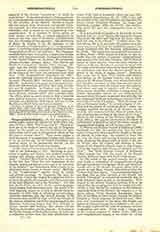

Congregational Singing : In his Instruction on sacred music, commonly referred to as the Motu Proprio (November 22, 1903), Pius X says (no. 3): “Special efforts are to be made to restore the use of Gregorian chant by the people, so that the faithful may again take a more active part in ecclesiastical offices, as was the case in ancient times”. These words suggest a brief treatment of congregational singing with respect to (a) its ancient use, (b) its formal prohibition and gradual decay, (c) its present-day revival, (d) the character which that revival may assume.
(a) The first testimony is found in the Epistle of St. Paul to the Ephesians (v, 19): “Speaking to your-selves in psalms, and hymns, and spiritual canticles, singing and making melody in your hearts to the Lord”. Cardinal Bona finds in these words a witness to the fact that “from the very beginnings of the Church, psalms and hymns were sung in the assembly of the faithful”, and understands them to refer to an alternated chant (mutuo et alterno cantu). McEvilly in his “Commentary” applies them to public and private meetings. St. Augustine (Ep. cxix, ch. xviii) says: “As to the singing of psalms and hymns, we have the proofs, the examples, and the instructions of the Lord Himself, and of the Apostles“. (Cf. also Col., iii, 16; I Cor., xiv, 26.) In the ancient congregational singing both sexes took part; the words of St. Paul imposing silence on women in church being interpreted to refer only to exhorting or instructing. Duchesne describes how the earliest worship of the Christians was parallel to that, not of the Temple of the Jews at Jerusalem, but of the local synagogues, the Christians borrowing thence their four elements of Divine service—the lections, the chants (of the Psalter), the homilies, and the prayers. In treating of the Syrian Liturgy of the fourth century, he makes up a composite picture from the 23rd catechetical discourse of St. Cyril of Jerusalem (about the year 347), the Apostolic Constitutions (II, 57; VIII, 5-15), and the homilies of St. John Chrysostom, and describes the Divine service (Christian Worship: Its Origin and Evolution, London, 1903, pp. 57-64), and incidentally shows the part the congregation took in the singing.
A council held at Laodicea in the fourth century decreed (can. xv), that “besides the appointed singers who mount the ambo and sing from the book, others shall not sing in the Church“. Cardinal Bona (Re-rum Liturg., Bk. I, ch. xxv, sect. 19) explains that this canon was issued because the unskillful singing of the people interfered with the decorous performance of the chant. The decree was not accepted everywhere, as Bona shows. With respect to France, he also remarks that the custom of popular (congregational) song ceased a few years after Caesarius; for the Second Synod of Tours decreed “that the laity, whether in vigils or at Masses, should not presume to stand with the clergy near the altar whereon the Sacred Mysteries are celebrated, and that the chancel should be reserved to the choirs of singing clerics”. Hereupon Sala notes (no. 4) that “this custom still obtains, nevertheless, in the Eastern Church; and in many places in the Western Church, very remote from cities, and therefore tenacious of older customs and less influenced by newer ones, the people learn the ecclesiastical chant and sing it together with the clergy”. Many causes, doubtless, combined to bring about the present lamentable silence of our congregations, amongst which the most prominent was probably the one mentioned by Bona as having occasioned thedecree of the Council of Laodicea. That the cause was not, as Dickinson thinks, “the steady progress of ritualism and the growth of sacerdotal ideas”, which “inevitably deprived the people of all initiative in the worship, and concentrated the offices of public devotion, including that of song, in the hands of the clergy” (Music in the History of the Western Church, New York, 1902, p. 48), may be inferred from the efforts of ecclesiastical authority to revive the older custom of congregational singing, as will be seen under (c).
The Second Plenary Council of Baltimore (1866) expressed (no. 380) its earnest wish that the rudiments of Gregorian chant should be taught in the parish schools, in order that “the number of those who can sing the chant well having increased more and more, gradually the greater part, at least, of the people should, after the fashion still existing in some places of the Primitive Church, learn to sing Vespers and the like together with the sacred ministers and the choir”. The Third Plenary Council of Baltimore (1884) repeats (no. 119) the words of the Second Council, prefacing them with denuo confirmemus.
The words of the quoted councils and of the pope imply a restoration of congregational singing through instruction in Gregorian chant, and therefore clearly refer to the strictly liturgical offices such as solemn or high Mass, Vespers, Benediction (after the Tantum Ergo has begun). Congregational singing at low Mass and at other services in the church, not strictly “liturgical” in ceremonial character, has always obtained, more or less, in our churches. With respect to the strictly liturgical services, it is to be hoped that the congregation may be instructed sufficiently to sing, besides the responses to the celebrant (especially those of the Preface), the ordinary (i.e. the Kyrie, Gloria, Credo, Sanctus, Benedictus, Agmis Dei) of the Mass in plain chant; leaving the Introit, Gradual or Tract sequence (if there be one), Offertory, and Communion to the choir; the Psalms and hymns at Vespers, leaving the antiphons to the choir. The singing might well be made to alternate between congregation and choir. Perosi made a strong plea to the musical congress of Padua (June, 1907) for such congregational singing of the Credo (cf. Civilta. Cattolica, July 6, 1907). (See Choir; Ecclesiastical Music; Choral Singing.)
H. T. HENRY

